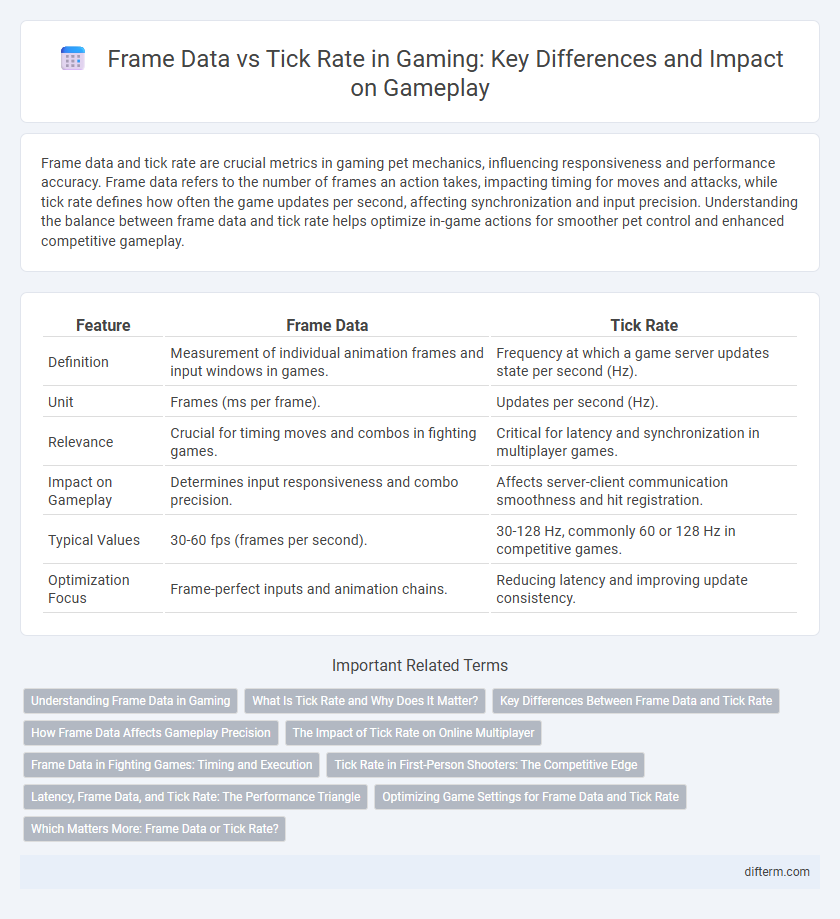Frame data and tick rate are crucial metrics in gaming pet mechanics, influencing responsiveness and performance accuracy. Frame data refers to the number of frames an action takes, impacting timing for moves and attacks, while tick rate defines how often the game updates per second, affecting synchronization and input precision. Understanding the balance between frame data and tick rate helps optimize in-game actions for smoother pet control and enhanced competitive gameplay.
Table of Comparison
| Feature | Frame Data | Tick Rate |
|---|---|---|
| Definition | Measurement of individual animation frames and input windows in games. | Frequency at which a game server updates state per second (Hz). |
| Unit | Frames (ms per frame). | Updates per second (Hz). |
| Relevance | Crucial for timing moves and combos in fighting games. | Critical for latency and synchronization in multiplayer games. |
| Impact on Gameplay | Determines input responsiveness and combo precision. | Affects server-client communication smoothness and hit registration. |
| Typical Values | 30-60 fps (frames per second). | 30-128 Hz, commonly 60 or 128 Hz in competitive games. |
| Optimization Focus | Frame-perfect inputs and animation chains. | Reducing latency and improving update consistency. |
Understanding Frame Data in Gaming
Frame data in gaming refers to the precise timing information of animations and actions, such as attack start-up, active, and recovery frames, which directly influence player strategy and reaction times. Tick rate indicates how frequently a game server updates the game state per second, affecting the responsiveness and synchronization of online gameplay. Understanding frame data allows players to optimize their moves and counterplays, while tick rate determines the smoothness and accuracy of input registration in competitive online gaming.
What Is Tick Rate and Why Does It Matter?
Tick rate refers to the number of times per second a game server updates the game state, typically measured in ticks per second (Hz). Higher tick rates, such as 128 Hz versus 60 Hz, result in smoother input responsiveness and more precise hit registration, crucial for competitive gaming performance. Understanding tick rate is essential for players seeking optimal gameplay accuracy and reduced latency in fast-paced multiplayer games.
Key Differences Between Frame Data and Tick Rate
Frame data represents the number of frames displayed per second in a game, directly influencing visual smoothness and animation detail, while tick rate refers to how often a game server updates the game state per second, affecting gameplay responsiveness and network synchronization. Frame data impacts client-side experience by determining how fluid movements and actions appear, whereas tick rate governs server-side accuracy, ensuring timely input recognition and consistent game physics. Understanding these distinctions is crucial for optimizing both graphical performance and competitive multiplayer responsiveness.
How Frame Data Affects Gameplay Precision
Frame data directly influences gameplay precision by determining the exact duration of each animation, allowing players to time moves and counterattacks with millisecond accuracy. Lower frame counts per action result in slower responsiveness, impacting a player's ability to execute combos or dodge attacks effectively. Understanding frame data alongside tick rate helps optimize input timing and enhances competitive performance in fast-paced gaming environments.
The Impact of Tick Rate on Online Multiplayer
Tick rate directly influences the responsiveness and smoothness of online multiplayer games by determining how often the server updates player actions per second. Higher tick rates result in more precise hit registration and reduced latency, giving players a competitive edge in fast-paced titles like first-person shooters or fighting games. Understanding the relationship between frame data and tick rate is essential for optimizing network performance and ensuring a consistent gameplay experience across different hardware setups.
Frame Data in Fighting Games: Timing and Execution
Frame data in fighting games details the exact duration, measured in frames, of each move, including startup, active, and recovery phases, crucial for precise timing and execution. Understanding frame data allows players to optimize combo sequences, punish opponents' mistakes effectively, and improve reaction times by knowing which moves are safe or punishable. Accurate knowledge of frame timings helps refine in-game strategies by maximizing frame advantage, directly impacting competitive performance and match outcomes.
Tick Rate in First-Person Shooters: The Competitive Edge
Tick rate in first-person shooters determines how often the game server updates player actions per second, directly impacting gameplay responsiveness and hit registration accuracy. Higher tick rates, such as 128 Hz compared to 60 Hz, reduce input lag and provide a smoother, more consistent experience crucial for competitive edge. Professional esports tournaments prioritize elevated tick rates to ensure fairness, precision, and real-time synchronization between players.
Latency, Frame Data, and Tick Rate: The Performance Triangle
Latency critically impacts gaming responsiveness by measuring the time between input and on-screen action. Frame data, including frame rate and frame time, determines how smoothly visuals are rendered per second. Tick rate reflects how often a game server updates player actions, creating a performance triangle where latency, frame data, and tick rate collectively influence gameplay accuracy and fluidity.
Optimizing Game Settings for Frame Data and Tick Rate
Optimizing game settings by balancing frame data and tick rate enhances gameplay responsiveness and precision, ensuring smoother animations and more accurate hit detection. High tick rates improve server communication frequency, while optimal frame data maximizes rendering efficiency on the player's device. Adjusting resolution, graphics quality, and network settings can synchronize frame output with tick updates, minimizing input lag and visual stutter.
Which Matters More: Frame Data or Tick Rate?
Tick rate measures how often a game server updates per second, directly affecting input responsiveness and hit registration accuracy in multiplayer gaming. Frame data refers to the duration frames take in an animation or move, influencing the smoothness of visual feedback and reaction timing for players. While both impact gameplay, tick rate holds greater importance for competitive online games due to its effect on latency and synchronization between players and the server.
frame data vs tick rate Infographic

 difterm.com
difterm.com